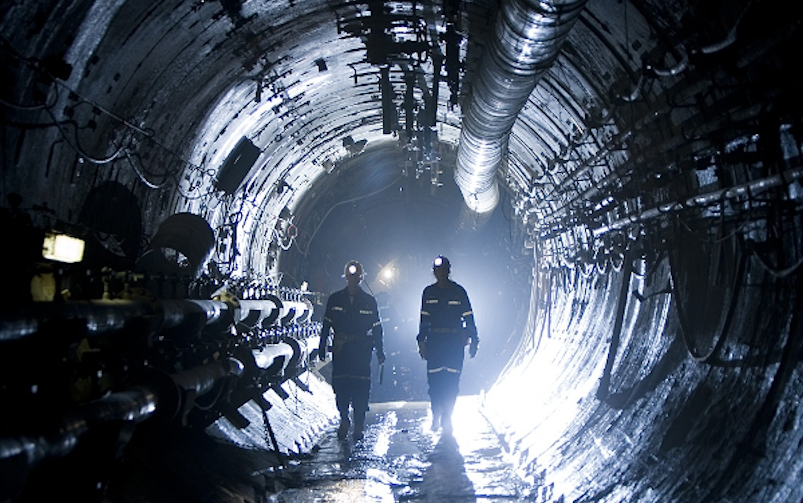Geoscience BC's high-resolution data focuses mineral exploration and investment. Courtesy of Geoscience BC.
(Like what you’re reading? Get our weekly recap delivered straight to your inbox each Friday.)
Welcome back to your weekly mining news recap, where we catch you up on some of the news you may have missed. This week’s headlines include Mag One’s magnesium production pilot project, British Columbia’s new energy minister, and CanmetMINING tests microwave energy for rock breakage.
The Muckahi method, a mine development concept that relies on a roof-mounted monorail, was put to the test at Torex Gold’s El Limón mine in Mexico. The two-lane monorail uses requires less excavation and can move ore at steeper angles than conventional operations. According to Torex president and CEO Fred Stanford, “this is just good old process engineering,” and estimates it will cut costs by 30 per cent.
CanmetMINING has been studying the use of microwave transmitters in rockbreaking for miners digging deeper for ore, with hopes that this technology will lead to more efficient mining operations and supplement traditional drilling and blasting in underground mining. Pejman Nekoovaght, a principal scientist at CanmetMINING, has been studying the effects of microwave energy on ores and rocks collected from different mines in order to eventually bring the project from the laboratory to the work site.
Blue Lagoon has signed a deal for up to $5.25 million to support Mag One’s magnesium production pilot project, which converts tailings waste into pure magnesium. Funding from Blue Lagoon will be used to complete pilot testing and begin engineering a demonstration plant to produce 30,000 and 33,000 tonnes of magnesium oxide and amorphous silica per year, respectively. Mag One estimates that the carbon footprint will be significantly lower than traditional magnesium production methods.
Geoscience BC released its survey data on northern Vancouver Island, which is intended to spur mineral exploration and development in the region. The data includes high-resolution maps and information about the magnetic and radiometric properties of rocks below and close to the surface. The survey covered an area of 6,127 square kilometres and is meant to allow geologists to better understand the mineralization and possible new deposits in the area.
B2Gold has announced the results of its preliminary economic assessment (PEA) for its Gramalote gold project in Colombia. According to the PEA, the Gramalote project would produce an estimated 416,600 ounces of gold per year for the first five years of production, have an initial project life of 13.6 years and an after-tax net present value of US$928 million at a five per cent discount rate, and an all-in sustaining cost of US$648 per ounce.
Saskatchewan’s Ministry of Environment approved Rio Tinto Exploration Canada’s request for permits to construct a 99-kilometre winter access trail to Forum Energy Metal’s Janice Lake copper exploration project. Rio Tinto will be able to earn 80 per cent interest in the Janice Lake project through completion of $30 million worth of mineral exploration in 2020. The proposed access trail and temporary work camp will permit further drilling and mineral exploration on the northeast side of the project’s Burbidge Lake in 2020 and 2021.
British Columbia has a new mining minister after a cabinet shuffle by Premier John Horgan. According to Global News, Horgan appointed Bruce Ralston as Minister of Energy, Mines and Petroleum Resources transferring former energy minister Michelle Mungall to the ministry of jobs, economic development and competitiveness. Ralston, who will continue to serve as lead minister for consular affairs, takes over the resources files amid public pressure around the proposed Coastal GasLink pipeline and liquid natural gas terminal that it would feed near Kitimat.
Brazilian state prosecutors have charged sixteen individuals with homicide for the Brumadinho tailings dam disaster, including former CEO of Vale Fabio Schvartsman, according to Reuters. The charges come almost a year after the disaster killed over 250 people, and includes 11 individuals who worked for Vale and five who worked for TUV SUD, the German company in charge of inspecting the dam. State prosecutors levelled additional charges of environmental crimes against both companies.
Barrick and the Tanzanian president John Pombe Magufuli, formalized a joint venture between Barrick and the government over the company’s North Mara, Bulyanhulu and Buzwagi mines. According to the agreement, Barricks’ local operations will be 84 per cent and 16 per cent owned by Barrick and the Tanzanian government, respectively, and will evenly divide the economic benefits of these mining operations between them once capital investments are recovered. Barrick will also be committing up to US$10 million for training and skills development in mining at the University of Dar es Salaam and will further commit over US$40 million to upgrade the road between the Bulyanhulu and Mwanza mines.
This week British Columbia’s Association for Mineral Exploration recognized the 2019 recipients of its Celebration of Excellence awards, in recognition of their significant efforts and contributions to the mining industry. Among those recognized included were the Diamonds in the Rough Emergency Rescue Organization, the first ever all-female mining rescue team to compete internationally, Peter Fischl, for his contribution to enhancing mineral resources in British Columbia and Yukon, as well as geologist Julia Lane, who was killed in an airplane crash while working in the field last August. Also recognized were Dr. Moira Smith and Ed Balon, among others.
If you’ve got feedback, you can always reach us at editor@cim.org. If you’ve got something to add, why not join the conversation at our Facebook, Twitter or LinkedIn pages? Like your recap with a few more gifs? Check out our mining news recap stories on our Instagram.



